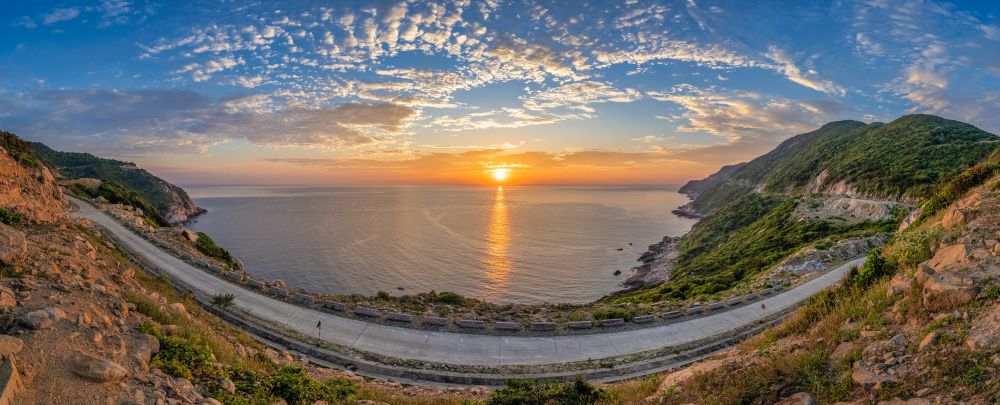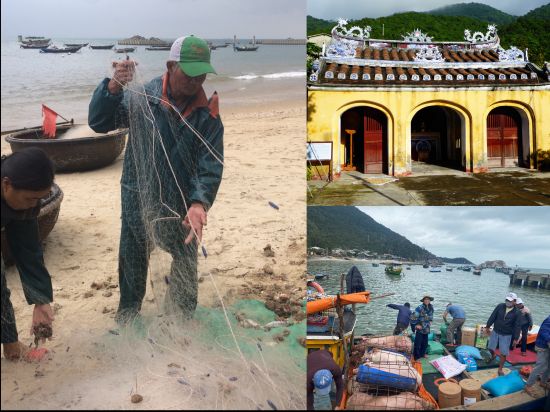Inspired by the environmental epic “Avatar: The Way of Water”, which is vying for the Best Picture Oscar at the Academy of Motion Picture Arts and Sciences Awards on March 12, James Borton of Johns Hopkins University recalls his time with the fisherfolk of Cu Lao Cham in Vietnam, who revere the sea from which they derive their livelihood.
No computer-generated imagery needed here: Dawn over Cu Lao Cham, a cinematic archipelago off the central coast of Vietnam (Credit: Nguyen Quang Ngoc Tonkin / Shutterstock.com)
Epic film “Avatar: The Way of Water”, sequel to the 2009 Best-Picture Academy Award nominee that won Canadian filmmaker James Cameron the Best Director statuette that year, is competing in four categories at the Oscars on March 12. Set on a tropical island, where a local indigenous tribe teaches the leading character and his family how connected they are to the ocean, Cameron’s cinematic creation mirrors his life and loves. Like the planet’s oceans, his fictional undersea world is in deep trouble and the film shows why.
As an international journalist, I saw the danger and how islanders who depend on the sea can show us how to protect their fragile marine resources. From the Philippines, where the sea-dwelling Badjao people or “Sea Nomads”, taught me how to dive for natural pearls in the Sulu Sea, to Cu Lao Cham, an archipelago 20 nautical miles off Vietnam’s central coast, where local fishers venture into the East Sea (how Vietnamese refer to the South China Sea), I have had a front row seat to learn from the real, not digitally conjured, reef people.
I vividly remember the first time I arrived by boat in Cu Lao Cham in 2016. The sky was a bright blue, the harbor calm. On the tidy dock were stacked bags of trash and signs that read “no plastic allowed”. Just as in Cameron’s film, beneath the waters were a collection of corals – vibrant pink, luminescent blue, sparkling golden-yellow, and gorgeous green. I would understand later from residents that these jewels of the sea were an important part of the local lore and legend.
In the past, this was a peaceful and glorious watery domain, where fishermen, not unlike Cameron’s mythical “Metkayina” islanders, plied their trade and preserved their culture. Today, the area has become the focal point of global security and environmental concern, even alarm – its various zones, shoals, reefs and man-made structures the subject of conflicting sovereignty claims, the venue for clashes among fisher people and between the fishers and militias and navy, the scene of criminal brutality against the corals, and the scene of an unfolding biodiversity and ecological disaster.
In this close-knit island community, located 23.2 kilometers from Hoi An on Vietnam’s central coast, the fishermen and their families share in the harvests of crabs, seaweed, mussels, and snails. The Cham Islands lie in a marine protected area (MPA) that was established by the Provincial People’s Committee of Quang Nam Province.
Chu Manh Trinh, a tireless 60-year-old marine biologist and natural resource management expert at the University of Da Nang, has been responsible for mapping out and securing the islanders’ commitment to protect the natural resources of the Cham archipelago and its peoples’ cultural heritage and values. Locals call him “thay” or “teacher Trinh”.
Since 2010, Vietnam has been engaged in an ambitious initiative to create national MPAs. As a result, the country established 16 of these zones within a decade. With fisheries collapsing and corals dying, there continues to be an urgent need to designate more such areas.
There is no sign yet that Vietnam and China will move in that direction. To be sure, marine scientists in China recognize the environmental dangers and their consequences, ranging from dramatically diminishing fish stocks to the loss of coral reefs. The development of MPAs benefit not just one nation but also help neighbors and all the regional waters regardless of sovereignty or territorial boundary. But can Vietnam’s attention to conservation, sustainability, and environmental rule in the waters they share with China convince Beijing to embrace this environmental approach?
Vietnam and China have a complex relationship going back more than 2,000 years. This includes a month-long border war in 1979 and perennial troubles in the South China Sea. In 1988, in the Johnson South Reef, Chinese soldiers killed over 70 Vietnamese and raised their national flag over the barren rock.
Not unlike the ocean connected tribe in James Cameron’s film, the Cu Lao Cham islanders prefer not to engage in such disputes, the present territorial wrangling only serving as a reminder of the symbolic and economic importance of the East Sea and the need to protect the island culture that was enriched and sustained by trade across it.
The Cham way of life extends to the protection of the gods of the seas – the whales. Cham beliefs about the mythic properties of these giants run as deep as the ocean. The fishermen and their ancestors regarded the ocean behemoths as their protectors, a spiritual role that they honor in a local museum. Locals and other Vietnamese fishers hold special ceremonies not only for whales, but also for dolphins and porpoises since they all belong to the order of cetaceans.
Fishers refuse to hunt or kill a cetacean because they believe that bad luck will result from such a barbarous act. In this respect, Vietnam is leading the region by example. In China last year, rescuers towed a beached 65-foot sperm whale in Ningbo back out to sea. Contrast this ethos of responsibility and respect for nature to Japan’s expanding whaling operations that are reported to be extending all the way down to the Antarctic as the Japanese aim to keep their traditions and culture alive, even though few still eat whale, which had been a cheap source of protein after World War II when they were still in abundance.
No paid actor earning a multimillion-dollar fee and a share of box-office receipts, Hoang speaks for more than his island, his people, the surrounding reefs and the ocean’s resources. Like Cameron, whose film is reported to have cost US$460 million to make, he speaks for our civilization and for all humanity and the generations to come.
Further reading:
James Borton
Foreign Policy Institute, School of Advanced International Studies (SAIS), Johns Hopkins University
Check out here for more research and analysis from Asian perspectives.




